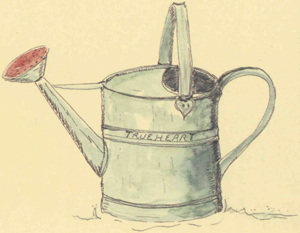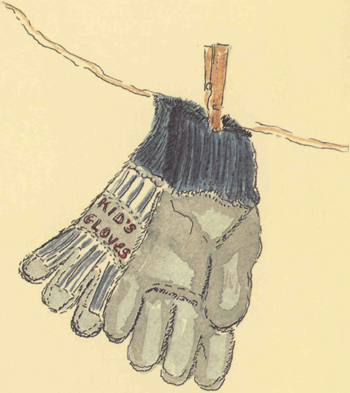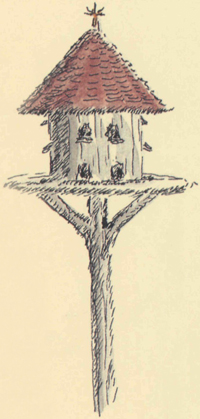Plants for Children
A Child’s Garden

Working and teaching in the gardens at Heart’s Ease, I have always tried to note which plants most attract children and why. Some plants act almost as magnets, drawing children back again and again.
What are the secret qualities that make certain plants favorites of children? Well, my friend Georgie (who has been an avid gardener for nearly 80 years!) says, “What children really need is to have a lot of things that grow fast.” She’s right. Kids want to see some sort of quick response to the work and care they’ve showered on their piece of land. Also important: Personality (faces in a pansy, sunflower, or snapdragon); fragrance (once thought to be the very soul of the flowers); texture (woolly lamb’s ear); and color—riotous, vibrant color.
Here are some of the plants I would choose for a children’s garden, but remember not to limit yourself to just this list. The key to keeping children’s sense of wonder and enjoyment alive is to let them make choices. Take the children to nurseries and let them search through the seed packets and flats of flowers for ones that twang their heartstrings. Allow them the freedom in their own gardens that they may not yet have in the rest of their lives.

All outdoors is warm and bright;
Robins sing with all their might,
And the garden seems to be
Just the place for you and me!
John Bowman

Perennials
Ballon Flower
Platycodon grandiflorus |
Just plain fascinating. |
Bleeding Heart
Dicentra spectabilis |
For fairy gondolas or earrings; a perfect flower for pressing. |
Chinese Lantern
Physalis alkekengi |
These brilliant orange globes look like real Chinese lanterns—perfect for a doll tea party. Exceptionally easy to grow and will self-sow prolifically. |
Columbine
Aquilegia spp. |
Also known as Little Doves or Granny’s Bonnets, these are the fairy shoes of flower dolls. |
Day Lily
Hemerocallis spp. |
These are colorful and easy to grow, provided you have lots of sun. Children can gather the blossoms and buds and cook them. The flower blossoms make skirts for dolls. |
Dollar Plant, Money Plant, or Honesty
Lunaria redeviva, or L. annua (a biennial) |
This makes play money, play dishes, gypsy jewelry. Easy to grow, and self-sows with abandon. |
False Dragonhead
Physostegia virginiana |
Kids can twist this into all sorts of funny positions and it will maintain the pose for hours (it is also referred to as Obedient Plant). |
Lady’s Mantle
Alchemilla spp. |
Children love the dew diamond in the middle of the leaf (a gift from the fairies, no doubt). |
Pink
Dianthus spp. |
“Fresh pinks cast incense on the air, In fluttering garments fringed and rare.” The scent remains in your memory forever. The petals are edible, and kids love to strew them in salads. Carnations (from the word coronet, and they can be made into coronets) are in this family, too. It’s fun to string pinks together to make garlands and jewelry. |
Poppy
Papaver orientale |
They make excellent dancing dolls on their stems. Children use them as water ballerinas, and they are fun to watch opening and closing (sometimes we have helped open them). The seed pods are like tiny rattles or pepper shakers. |
Stock
Matthiola incana |
They have a sweet scent and are good in sand castles and in a moonlight or flower-dial garden. There are also annual stocks that are easy to start from seed. |
Sunflower
Helianthus annuus |
Sunflowers have true personalities, they attract birds and bees, they are the framework for our sunflower house, and the seeds are yummy. The mature flower heads can be harvested and used as birdfeeders. No children’s garden can be considered complete without the whimsical presence of sunflowers. |


Annuals

Cornflower, Bachelor’s Button
Centaurea cyanus |
A good garland flower, and their rich blue and purple colors are jewels. |
Cosmos
Cosmos bipinnatus |
Brilliant and easy to grow, they attract lots of butterflies. My son Noah chose cosmos out of hundreds of plants in a nursery. They became his flower and were always planted outside our front door. |
Four o’clock
Mirabilis jalapa |
These plants amaze me every day when they open at about 4 p.m., and at night they attract the wonderful, fascinating hummingbird moth. |
Calendula
Calendula officinalis |
The old-fashioned marigold. This is one of the plants that can be held under the chin to see if you like butter. Individual flower petals can be used in salads and in rice dishes. Sit your child down at a table and let him add petals to dishes as you cook. These flowers are easy to grow. |
Love-in-a-mist
Nigella damascena |
Its seed pods are wonderful—the tiny seeds shake out like pepper, and the pods can be used as teacups. |
Moss Rose
Portulaca grandiflora |
Brilliant and easy to grow, they belong in the flower-dial garden. |
Nasturtium
Tropaeolum majus |
The Elizabethans called them yellow lark’s heels. These fiery charmers attract hummingbirds and children. With their peppery flavor, they can be used in salads or stuffed with cream cheese; children love to fill up the blooms and giggle as they eat them. The blossoms can be used in flower crowns and in leis and as hats on flower dolls. |
Heart’s Ease
Viola tricolor |
Also called johnny-jump-ups. Who can resist those faces? Teach the children how to make heart’s ease dolls. |
Snapdragon
Antirrhinum majus |
Along with hollyhocks, pansies, and sunflowers, this is one of the “personality” flowers. Snapdragons are great for hiding secret messages, making clip-on earrings, having snapdragon battles, or using like paper clips on each placecard at a child’s birthday party. |
Sweet Alyssum
Lobularia maritima |
It spreads like a delicate carpet of snow, and children love the tiny, almost miniature bouquet blossoms. These flowers, like the tiny blossoms of thyme, fit perfectly into a child’s fairy garden. |
Sweet Pea |
A little more difficult to cultivate, but worth the try just for the colors if not for the fantastic scent that children of all ages love! |
Verbena
Verbena × hybrida |
Colorful and easy to grow, it attracts skippers and other butterflies. |
Zinnia
Zinnia elegans |
Easy to grow and colorful, they also attract the skippers and other butterflies that bring so much life into a garden. A child-sized variety is fittingly called Thumbelina. |

the perfect nursery!
• Buy your eggs in the old-fashioned egg carton.
• Tear off the lid, fill the egg holes with good potting soil.
• Plant the seeds in each egg hole.
• Water daily.
• When the seedlings are about an inch high, gently tear or cut each egg compartment from the carton.
• Each seedling may be planted still in its cardboard egg holder.
• The cardboard will quickly disintegrate.
Biennials
Canterbury Bell
Campanula medium |
Whole quadrilles of dolls with canterbury bell skirts can be formed on twigs and lined up for dancing. |
English Daisy
Bellis perennis |
Easy to grow, can be made into daisy chains, daisy grandmothers, garlands, and ‘he-loves-me, he-loves-me-not’ charms. |
Forget-me-not
Myosotis sylvatica |
Soft, green, mouse-ear leaves with sky blue eyes. These are grown easily in very shady spots and children love to use them in miniature bouquets. |
Hollyhock
Alcea rosea |
The all-purpose flower. They attract hummingbirds and bumblebees, they make great dolls, fairy goblets, and leis, and my favorite, firefly lanterns! The seed pods make good play money, too. |
Sweet William
Dianthus barbatus |
An old-fashioned flower that is extremely easy to grow and can even take a little neglect; it loves to be picked for bouquets or all kinds of flower projects. |
Herbs
Garden Cress
Lepidium sativum |
A fast growing herb that gives children a feeling of instant success. Have the child write his or her name in cress seed, and watch it grow. |
Fennel
Foeniculum vulgare |
A must for the back wall in your garden. This hardy plant provides food for the caterpillars of swallowtail butterflies. The caterpillars are incredibly beautiful and fascinating and the kids will watch the brilliantly mosaicked “pillars” eating their way from one branch to another. Fennel is a nibbler plant. Kids love to pick the tender, dark new growth and chew it like gum. It makes a soothing tea for upset stomachs, but best of all, it helps bring more butterflies into our world. |
Lemon Verbena
Aloysia triphylla |
When children visit my garden, they always return again and again to the lemon verbena. When they leave, their pockets are usually stuffed full of the aromatic lemon-scented leaves. They know they can dry them for potpourri or use them in tea or just keep them in their pockets and pull them out for sweet smelling during the day. |
Mint
Mentha spp. |
Easy to propagate from cuttings, its tangy, sweet leaves are great in teas, sachets, potpourris, and dream pillows. Kids just love to chew them. My favorite is the orange-bergamot variety. |
Scented Geranium
Pelargonium spp. |
Easy to grow from cuttings and tolerant of drought, they make a good houseplant for children. The leaves, smelling of rose, apple, lemon, mint, nutmeg, or dozens of other scents, are intriguing to kids as they hop from one to another and try to determine what they are smelling. Flowers can be used in cookies, teas, cakes, icings, syrups, fruit sorbets, fruit salads, and vinegars. Leaves are excellent in homemade potpourri mixes. |
Woolly Lamb’s Ear
Stachys byzantina |
A touch-me, rub-me-on-your-cheek, and keep-me plant. Children spend lots of time at our woolly lamb’s ear patch. I allow them to pick leaves and save them as bookmarks or to mail them off in letters. They are even more fascinated when I tell them that in olden days they were used as bandages! |

My grass is green
My sky is blue—
I sing a song
of spring for you!
Roses
Roses are not easy for children to grow or to play around, but they really are a must near a child’s garden area. My favorite for ease of care, fragrance, and plump, beautiful rosehips, is the old-fashioned Rosa rugosa.
Children love to eat rose petals in rosy-cakes, they rub them on their lips as lipstick, or use them as fragile, tiny note paper for rose-notes to a special friend. Pea pod boats must have sails of rose petals or rose leaves! Perfect, doll-sized teapots can be made with a rosehip, stuck with a thorn for a spout. Necklaces can be strung with rosehips, and rosehip dolls can be made. You can brew up a cup of rosehip or rose petal tea for your tired little ones at the end of a long, hard day of play in the garden.
In California there is an Indian tribe that calls roses “Ska Pash Wee”, which means, “Mean old lady, she sticks me!” Remember that rose thorns can be mean, so plant them out of the children’s play area; but do plant them.

Perfect, doll-sized teapots can be made with a rosehip, stuck with a thorn for a spout.
Vegetables
Carrots
|
The minis (called Little Fingers) are the best for children and they can easily be grown in a container. Kids love to pull the little finger-sized carrots and eat them raw. They’re a hundred times better than the giant, woody, tasteless ones you get in a market. A swag of carrots can be hung on your door with ribbon to help greet the Easter bunny, or a bunny tussie-mussie can be made with carrots and radishes, surrounded by the herbs of your choice and beribboned like a floral tussie-mussie. |
Decorative Gourds of all types
|
They can be used as bird houses, dippers, bowls, doll coaches, storage containers, baby rattles, false hen setting eggs, pretend dinosaur eggs, and Christmas tree ornaments. Young, tiny gourds can be made into gourd dolls. A variety called the spaghetti gourd or squash is a delicious, edible oddity as tasty as the pasta for which it was named. |
Easter Egg Eggplant
Solanum melongena |
An aptly named ornamental edible that can be grown in containers. Fruit is satin-white and egg-shaped. |
Fraises des bois, or Alpine Strawberries
Fragaria vesca |
Not a vegetable, but these should have a place somewhere in your garden! The kids call them fairy berries at Heart’s Ease and they head straight for the berry borders to fill up on the tasty little gems. The love children feel for these berries cannot be equated with their size! |
Painted Lady Beans
Phaseolus coccineus var. |
Heirloom British pole beans that love to clamber over trellises, arches, and teepees. This bean flowers prolifically and produces beautiful coral and white flowers with a sweet, light bean flavor—yes, the blooms are edible and can be used in salads, sandwiches, and as a great snack. |
Pumpkins
Cucurbita pepo |
Both the mini and giant varieties are great personality plants to have in a garden. Pumpkins can be scratched with a nail, and as they grow the etched name or message grows. |
Radishes
Raphanus sativus |
They are so easy to grow that they make children feel like master gardeners. Several seed companies now have a variety of radishes called “Easter Egg”. These delicious round radishes are colored lavender, red, pink, and white. What a surprising treat for kids! |
Scarlet Runner Beans
Phaseolus coccineus var. |
Fast growing, attracts hummingbirds, and makes excellent teepees. The red flowers are edible. |
Strawberry Popcorn and Miniature Indian Corn
Zea mays var. |
These are kid-sized. The strawberry popcorn produces a truly strawberry looking head of corn that can be popped (if you have the heart). The mini Indian corns are loved by children because of their charm and tiny size; they make wonderful miniature corn husk dolls. ‘Pretty Pops’ has confetti-colored kernels of red, blue, orange, black, yellow, and purple that show white when popped. The ears are a great Thanksgiving or autumn table decoration. |
Tomatoes
Lycopersicum spp. |
These can make children feel as if they are really accomplishing something. ‘Currant’ tomatoes are pea sized and would be perfect in a miniature vegetable garden. ‘Yellow Marble’ is, you guessed it, the size of marbles. |
Tools of the farmer’s trade



Vines
Cup and Saucer Vine
Cobaea scandens |
A ready-made tea set. Flowers open yellow-green and age to a rich purple. |
Hoenysuckle
Lonicera japonica |
This sometimes pesky vine has the sweet-tasting flower children love to suck. The vine attracts hummingbirds and the long, supple branches are easily woven into baskets and crowns. The flowers can be stuck inside each other, forming a continuous chain of blooms. Children wear the strings of blooms as crowns, belts, and necklaces. |
Hops
Humulus lupulus |
Fast growing; so fast, in fact, that people often place bets on how much a vine will grow during the hot summer nights. |
Moon Flower
Ipomoea alba |
Attracts night moths, including the fascinating hummingbird moth; it is fun to watch the flower as it opens at night. |
Morning Glory
Ipomoea purpurea |
Certain varieties attract hummingbirds, and the ‘Heavenly Blue’ is the roof of the sunflower playhouse (see here). |
Trumpet Vine
Campsis radicans |
Attracts hummingbirds, makes great dolls and bubble blowers. |











